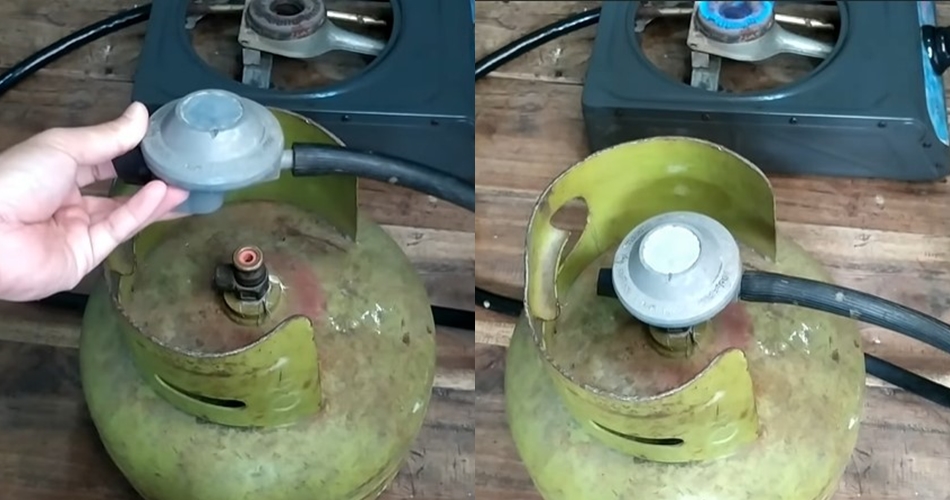YouTube/SAHABAT GAS
Brilio.net - There are many people who choose to retreat regularly when they have to deal with LPG gas cylinders. The reason is, the gas cylinder can leak, especially when installing the regulator. This experience regarding dealing with LPG gas cylinder leaks was also shared by YouTube account user SAHABAT GAS.
According to him, one of the most common reasons why gas cylinders can leak is the regulator's position being loose. That's why many people choose to buy and replace a new gas regulator with one of relatively higher quality and price. However, this guy who uses YouTube, FRIENDS OF GAS, has another trick without having to buy a new one, you know.
" The regulator can become loose because the regulator lock is starting to wear out , so when we attach it to the LPG gas cylinder, the lock is not very strong, so the gas leaks, and the regulator also shakes," he said, quoted by BrilioFood from YouTube SAHABAT GAS on Wednesday (10/ 4).
There are many tricks to deal with leaking gas cylinders without having to spend money buying a new regulator. One of them, you can insert a piece of used tire rubber into the hole in the LPG gas cylinder. However, the man on the YouTube account SAHABAT GAS has another tool that is much simpler.
Tricks for dealing with leaking gas cylinders using the addition of 1 simple tool.
The first tool that must be prepared is the rubber seal that comes with the gas cylinder. However, you don't need to use the rubber seal as a whole, but first cut it into 2 parts, then use only half.
On the other hand, you also need rubber bands. Yup, this rubber band is the main tool that must be added to practice this trick for dealing with leaking gas cylinders. Cut the rubber band to the size of the LPG gas cylinder hole diameter.
After cutting, immediately insert the piece of rubber band in a circle into the tube hole, then overwrite it with the rubber seal that was cut previously.
"So the rubber band is not tied to the neck of the tube, OK," emphasized the owner of the YouTube account SAHABAT GAS.

photo: YouTube/FRIENDS OF GAS
Next, attach the regulator to the LPG gas cylinder and lock it until it is completely tight. Before turning on the stove, it is better to first observe carefully whether there is still a hissing sound and the smell of sulfur coming from the gas cylinder. If there is no reaction, it means the LPG gas cylinder is no longer leaking.

photo: YouTube/FRIENDS OF GAS
So, how practical is this trick for dealing with leaking gas cylinders? Taking a peek at GAS FRIENDS' YouTube upload, apart from having been watched 51 thousand times, the comments column is also filled with enthusiasm from other netizens, you know.
How to deal with a gas stove flame that is no longer blue.
If the gas stove flame is not blue, it could be a sign of a problem that needs to be fixed. Here are some steps you can try to solve this problem.
1. Clean the burner holes.
Sometimes, dirt or food residue can clog the burner holes. Turn off the stove and let it cool before carefully cleaning the burner holes using a brush or toothpick.
2. Check gas pressure.
Make sure the gas pressure in the gas cylinder is sufficient to produce a strong flame. Also check that the gas hose does not leak and is installed correctly.
3. Check the gas regulator.
The gas regulator regulates the flow of gas to the stove. Make sure the gas regulator is functioning properly and is not damaged. If necessary, replace the damaged regulator.
4. Adjust the valve position.
On some types of gas stoves, there is a small valve that regulates the air entering the gas mixture for combustion. Try to readjust this small valve to try to improve combustion.
5. Check for carbon monoxide.
If the stove flame is not blue and looks yellow, it could be a sign of incomplete combustion and producing carbon monoxide. If you suspect carbon monoxide, turn off the stove immediately, open a window for ventilation, and leave the room immediately. Carbon monoxide is very dangerous for health.
6. Call a technician.
If after trying the steps above the problem is not resolved, there may be a more complex problem with your gas stove. Call a technician or gas stove repair expert to check it and repair it.
It is important to remember that safety should be the top priority when dealing with problems with a gas stove. If you are unsure or have no knowledge about gas stove repair, it is better to call a trained professional.
(brl/lut)